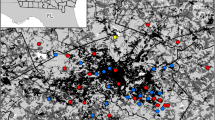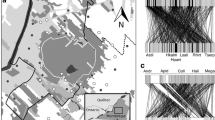Abstract
Wild bee communities persist in cities despite major disruption of nesting and food resources by urban development. Bee diversity and abundance is key for urban agriculture and maintenance of plant diversity, and assessing what aspects of cities enhance bee populations will promote our capacity to retain and provision bee habitat. Here, we assessed how variation in land cover and neighborhood development history affected bee communities in the midwestern US urban landscape of Madison, Wisconsin. We sampled bee communities across 38 stratified sites with relatively high (>55%) or low (<30%) levels of impervious surface, and assessed effects of land use and neighborhood development history on bee abundance and species richness. We show abundance and richness of soil nesting bees was lower in newer neighborhoods. Soil nesting bees and bee community richness decreased as cover of impervious surface increased, but above ground nesting bees were minimally impacted. Bee community similarity varied spatially and based on dissimilar local land cover, only for soil nesting bees, and the overall bee community. Impervious surface limited bee abundance and diversity, but new neighborhoods were associated with greater negative effects. We suggest that enhancing the structural diversity of new neighborhoods in urban ecosystems may imitate the structural benefits of older neighborhoods for bee populations.



Similar content being viewed by others
Availability of data and material
Bees are submitted to the University of Wisconsin-Madison insect museum.
Code availability
References
Ascher JS, Pickering J (2013) Discover Life bee species guide and world checklist (Hymenoptera: Apoidea: Anthophila). http://www.discoverlife.org/mp/20q?guide=Apoidea_species. Accessed Oct 2018.
Banaszak-Cibicka W, Zmihorski M (2020) Are cities hotspots for bees? Local and regional diversity patterns lead to different conclusions. Urban Ecosyst 23:713–722. https://doi.org/10.1007/s11252-020-00972-w
Biesmeijer J et al (2006) Parallel declines in pollinators and insect-pollinated plants in Britain and the Netherlands. Science 313:351–354. https://doi.org/10.1126/science.1127863
Buchholz S, Egerer MH (2020) Functional ecology of wild bees in cities: towards a better understanding of trait-urbanization relationships. Biodivers Conserv 29:2779–2801. https://doi.org/10.1007/s10531-020-02003-8
Cane JH, Minckley RL, Kervin LJ, Roulston TH, Williams NM (2006) Complex responses within a desert bee guild (Hymenoptera: Apiformes) to urban habitat fragmentation. Ecol Appl 15(2):632–644. https://doi.org/10.1890/1051-0761(2006)016[0632:CRWADB]2.0.CO;2
Carpenter SR, Benson BJ, Biggs R, Chipman JW, Foley JA, Golding SA, Hammer RB, Hanson PC, Johnson PTJ, Kamarainen AM, Kratz TK, Lathrop RC, McMahon KD, Provencher B, Rusak JA, Solomon CT, Stanley EH, Turner MG, Vander Zanden MJ, Wu CH, Yuan H (2007) Understanding regional change: a comparison of two lake districts. Bioscience 57:323–335. https://doi.org/10.1641/B570407
Cohen H, Philpott SM, Liere H, Lin BB, Jha S (2020) The relationship between pollinator community and pollination services is mediated by floral abundance in urban landscapes. Urban Ecosystems 24:275–290. https://doi.org/10.1007/s11252-020-01024-z
Cusser S, Neff JL, Jha S (2018) Land-use history drives contemporary pollinator community similarity. Landscape Ecol 33:1335–1351. https://doi.org/10.1007/s10980-018-0668-2
Daily GC (1997) Nature’s Services: Societal Dependence on Natural Ecosystems. Island Press, Washington, DC
Daniels B, Jedamski J, Ottermanns R, Ross-Nickoll M (2020) A “plan bee” for cities: Pollinator diversity and plant-pollinator interactions in urban green spaces. PLoS ONE 15:e0235492. https://doi.org/10.1371/journal.pone.0235492
Ferrari A, Polidori C (2022) How city traits affect taxonomic and functional diversity of urban wild bee communities: insights from a worldwide analysis. Apidologie 53:46. https://doi.org/10.1007/s13592-022-00950-5
Fetridge ED, Ascher JS, Langellotto GA (2008) The bee fauna of residential gardens in a suburb of New York City (Hymenoptera: Apoidea). Ann Entomol Soc Am 101:1067–1077. https://doi.org/10.1603/0013-8746-101.6.1067
Fortel L, Henry M, Guilbaud L, Guirao AL, Kuhlmann M, Mouret H, Vaissière BE (2014) Decreasing abundance, increasing diversity and changing structure of the wild bee community (Hymenoptera: Anthophila) along an urbanization gradient. PLoS ONE 9(8):e104679. https://doi.org/10.1371/journal.pone.0104679
Fox J, Weisberg S, Price B, Adler D, Bates D, Baud-Bovy G, Bolker B, Ellison S, Firth D, Friendly M, et al. (2018) ‘car’ R package. Version 3.0–2
Frankie GW, Thorp RW, Hernandez J et al (2009) Native bees are a rich natural resource in urban California gardens. Calif Agric 63:113–120. https://doi.org/10.3733/ca.v063n03p113
Gathof AK, Grossmann AJ, Herrmann J, Buchholz S (2022) Who can pass the urban filter? A multi-taxon approach to disentangle pollinator trait-environmental relationships. Oecologia 199:165–179
Gibbs J (2011) Revision of the metallic Lasioglossum (Dialictus) of eastern North America (Hymenoptera: Halictidae: Halictini). Zootaxa 3073:1–216
Goddard MA, Benton DAJ, TG, (2010) Scaling up from gardens: biodiversity conservation in urban environments. Trends Ecol Evol 25:90–98. https://doi.org/10.1016/j.tree.2009.07.016
González-Varo JP, Biesmeijer JC, Bommarco R, Potts SG, Schweiger O, Smith HG, Steffan-Dewenter I, Szentgyörgyi H, Woyciechowski M, Vilà M (2013) Combined effects of global change pressures on animal-mediated pollination. Trends Ecol Evol 28:524–530. https://doi.org/10.1016/j.tree.2013.05.008
Goslee S, Urban D (2017) ‘ecodist’: R package for dissimilarity-based functions for ecological analysis. Version 2:1
Hall DM, Camilo GR, Tonietto RK, Ollerton J, Ahrne K, Arduser M, Ascher JS, Baldock KCR, Fowler R, Frankie G, Goulson D, Gunnarsson B, Hanley ME, Jackson JI, Langellotto G, Lowenstein D, Minor ES, Philpott SM, Potts SG, Sirohi MH, Spevak EM, Stone GN, Threlfall CG (2016) The city as a refuge for insect pollinators. Conserv Biol 31:24–29. https://doi.org/10.1111/cobi.12840
Hodgson K, Caton Campbell M, Bailkey M (2011) Urban Agriculture: Growing Healthy, Sustainable Places. American Planning Association, Chicago
Hoehn P, Tscharntke T, Tylianakis JM, Steffan-Dewenter I (2008) Functional group diversity of bee pollinators increases crop yield. Proc Biol Sci 7:2283–2291. https://doi.org/10.1098/rspb.2008.0405
Jha S, Kremen C (2013) Urban land use limits regional bumble bee gene flow. Mol Ecol 22(9):2483–2495
Larsen TH, Williams N, Kremen C (2005) Extinction order and altered community structure rapidly disrupt ecosystem functioning. Ecol Lett 8:538–547
Locke DH, Polsky C, Grove JM, Groffman PM, Nelson KC et al (2019) Residential household yard care practices along urban-exurban gradients in six climatically-diverse U.S. metropolitan areas. PloS One 14(11):e0222630
Martins AC, Goncalves RB, Melo GAR (2013) Changes in wild bee fauna of a grassland in Brazil reveal negative effects associated with growing urbanization during the last 40 years. Zoologia 30:157–176. https://doi.org/10.1590/S1984-46702013000200006
Matteson KC, Ascher JS, Langellotto GA (2008) Bee richness and abundance in New York City urban gardens. Ann Entomol Soc Am 101:140–150. https://doi.org/10.1603/0013-8746(2008)101[140:BRAAIN]2.0.CO;2
McFrederick QS, LeBuhn G (2006) Are urban parks refuges for bumble bees Bombus spp. (Hymenoptera:Apidae)? Biol Conserv 129:372–382. https://doi.org/10.1016/j.biocon.2005.11.004
McKinney ML (2008) Effects of urbanization on species richness: a review of plants and animals. Urban Ecosyst 11:161–176. https://doi.org/10.1007/s11252-007-0045-4
Mitchell TB (1960) Bees of the eastern United States. Technical Bulletin (North Carolina Agricultural Experiment Station), 141:1–538
Muggeo VM (2008) segmented: an R Package to Fit Regression Models with Broken-Line Relationships. R News 8(1):20–25. https://cran.r-project.org/doc/Rnews/
O’Connell M, Jordan Z, McGilvray E, Cohen H, Liere H, Lin BB, Philpott SM, Jha S (2021) Reap what you sow: local plant composition mediates bumblebee foraging patterns within urban garden landscapes. Urban Ecosyst 24:391–404. https://doi.org/10.1007/s11252-020-01043-w
Oksanen J, Guillaume Blanchet F, Friendly M, Kindt R, Legendre P, McGlinn D, Minchin PR, O’Hara RB, Simpson GL, Solymos P, Henry M, Stevens H, Szoecs E, Wagner H (2018) ‘vegan’ R package: community ecology package. Version 2.5–3
Ossola A, Locke D, Lin B, Minor E (2019) Greening in style: Urban form, architecture and the structure of front and backyard vegetation. Landsc Urban Plan 185:141–157
Pereira FW, Carneiro L, Goncalves RB (2021) More losses than gains in ground-nesting bees over 60 years of urbanization. Urban Ecosyst 24:233–242. https://doi.org/10.1007/s11252-020-01030-1
Persson AS, Ekroos J, Olsson P, Smith HG (2020) Wild bees and hoverflies respond differently to urbanization, human population density and urban form. Landsc Urban Plan 204:103901. https://doi.org/10.1016/j.landurbplan.2020.103901
Rebele F (1994) Urban ecology and special features of urban ecosystems. Glob Ecol Biogeogr Lett 4:173–187. https://doi.org/10.2307/2997649
Reeher P, Novotny JL, Mitchell RJ (2020) Urban bumble bees are unaffected by the proportion of intensely developed land within urban environments of the industrial Midwestern USA. Urban Ecosyst 23:703–711. https://doi.org/10.1007/s11252-020-00965-9
Renner SS, Graf MS, Hentschel Z, Krause H, Fleischmann A (2021) High honeybee abundances reduce wild bee abundances on flowers in the city of Munich. Oecologia 195:825–831. https://doi.org/10.1007/s00442-021-04862-6
Riera JP, Voss R, Carpenter SR, Kratz TK, Lillesand TM, Schnaiberg JA, Turner MG, Wegener MW (2001) Nature, society and history in two contrasting landscapes in Wisconsin, USA: interactions between lakes and humans during the 20th century. Land Use Policy 18:41–51
Ripley B, Venables B, Bates DM, Hornik K, Gebhardt A, Firth D (2018) MASS R package. Version 7(3–51):1
Rosenzweig ML (2003) Reconciliation ecology and the future of species diversity. Oryx 37:194–205. https://doi.org/10.1017/S0030605303000371
Sakagami SF, Michener CD (1962) The nest architecture of the sweat bees (Halictinae): a comparative study of behavior. University of Kansas Press, Lawrence
Schnore LF, Klaff VZ (1972) Suburbanization in the Sixties: A Preliminary Analysis. Land Econ 48:23–33
Sexton A, Benton S, Browning AC, Emery SM (2021) Reproductive patterns of solitary cavity-nesting bees responsive to both local and landscape factors. Urban Ecosyst. https://doi.org/10.1007/s11252-021-01116-4
Silva JLS, de Oliveira MTP, Cruz-Neto O, Tabarelli M, Valentina Lopes A (2021) Plant–pollinator interactions in urban ecosystems worldwide: A comprehensive review including research funding and policy actions. Ambio 50:884–900. https://doi.org/10.1007/s13280-020-01410-z
Steffan-Dewenter I, Munzenberg U, Burger C, Thies C, Tscharntke T (2002) Scale-dependent effects of landscape context on three pollinator guilds. Ecology 83:1421–1432. https://doi.org/10.1890/0012-9658(2002)083[1421:SDEOLC]2.0.CO;2
Stone B (2004) Paving over paradise: how land use regulations promote residential imperviousness. Landsc Urban Plan 69:101–113
Theodorou P, Radzevidiute R, Settele J, Schweiger O, Murray TE, Paxton RJ (2016) Pollination services enhanced with urbanization despite increasing pollinator parasitism. Proceedings R Soc B 283:20160561. https://doi.org/10.1098/rspb.2016.0561
Theodorou P, Herbst SD, Kahnt B, Landaverde-Gonzalez P, Baltz LM, Osterman J, Paxton R (2020) Urban fragmentation leads to lower floral diversity, with knock-on impacts on bee biodiversity. Sci Rep 10:21756. https://doi.org/10.1038/s41598-020-78736-x
Threlfall CG, Walker K, Williams NSG, Hahs AK, Mata L, Stork N, Livesley SJ (2015) The conservation value of urban green space habitats for Australian native bee communities. Biol Cons 187:240–248
Tonietto R, Fant J, Ascher J, Ellis K, Larkin D (2011) A comparison of bee communities of Chicago green roofs, parks, and prairies. Landsc Urban Plan 103:102–108
Turo KJ, Spring MR, Sivakoff FS, Delgado de la flor YA, Gardiner MM, (2019) Conservation in post-industrial cities: How does vacant lot management and landscape configuration influence urban bees. J Appl Ecol 58:58–69. https://doi.org/10.1111/1365-2664.13773
U.S. Census Bureau (2010) Madison city, Wisconsin Populations and People. U.S. Department of Commerce. Retrieved 23 Apr 2023, from https://data.census.gov/
USGS 1-foot urban aerial ortho photographs (2010) Accessed via WisconsinView data portal. http://relief.ersc.wisc.edu/wisconsinview/form.php
Wegener MW (2001) Long-term land use/cover change patterns in the Yahara Lakes region and their impact on runoff volume to Lake Mendota. Master’s thesis. University of Wisconsin, Madison
Wilson CJ, Jamieson MA (2019) The effects of urbanization on bee communities depends on floral resource availability and bee functional traits. PLoS ONE 14(12):e0225852. https://doi.org/10.1371/journal.pone.0225852
Winfree R, Vazquez AR, DP, LeBuhn G, Aizen MA, (2009) A meta-analysis of bees’ responses to anthropogenic disturbance. Ecology 90:2068–2076. https://doi.org/10.1890/08-1245.1
Wojcik VA, Frankie GW, Thorp RW, Hernandz JL (2008) Seasonality in bees and their floral resource plants at a constructed urban bee habitat in Berkeley, California. J Kansas Entomol Soc 81:15–28. https://doi.org/10.2317/JKES-701.17.1
Funding
Department of Entomology, University of Wisconsin-Madison.
Author information
Authors and Affiliations
Contributions
VWP designed study, performed analysis and drafted manuscript, JSB and DWC participated in manuscript review. All authors gave final approval for publication.
Corresponding author
Ethics declarations
Conflict of interest
The authors declare they have no conflict of interest.
Supplementary Information
Below is the link to the electronic supplementary material.
Rights and permissions
Springer Nature or its licensor (e.g. a society or other partner) holds exclusive rights to this article under a publishing agreement with the author(s) or other rightsholder(s); author self-archiving of the accepted manuscript version of this article is solely governed by the terms of such publishing agreement and applicable law.
About this article
Cite this article
Pfeiffer, V., Crowder, D.W. & Silbernagel, J. Urban development reduces bee abundance and diversity. Urban Ecosyst 26, 1535–1544 (2023). https://doi.org/10.1007/s11252-023-01393-1
Accepted:
Published:
Issue Date:
DOI: https://doi.org/10.1007/s11252-023-01393-1




